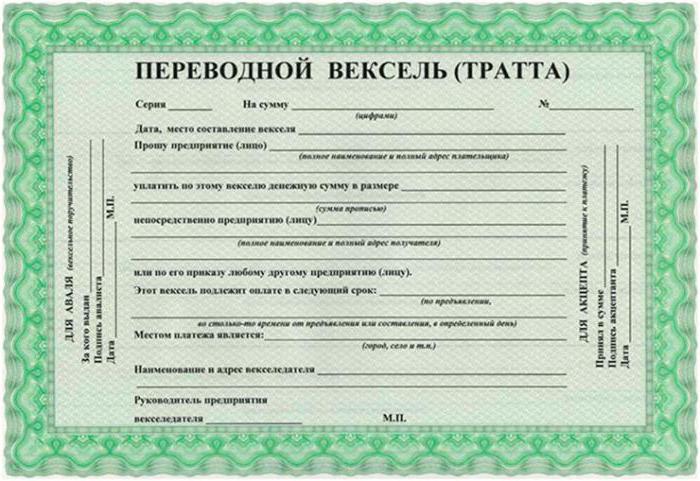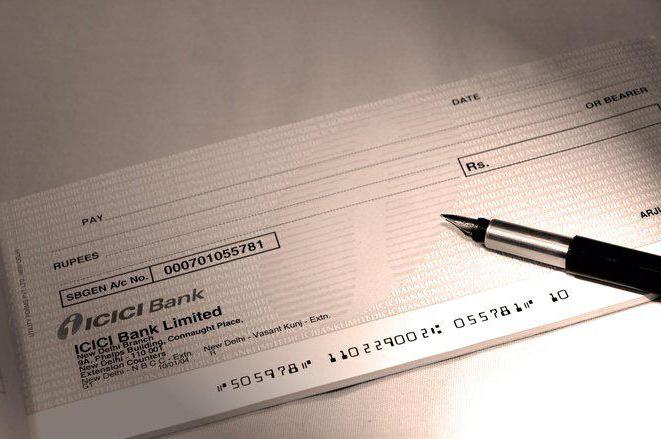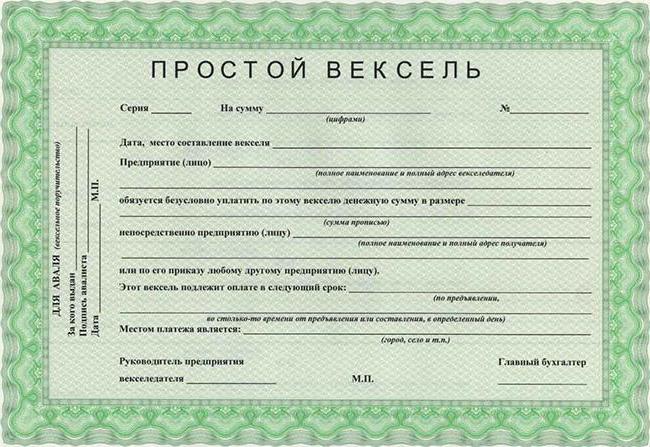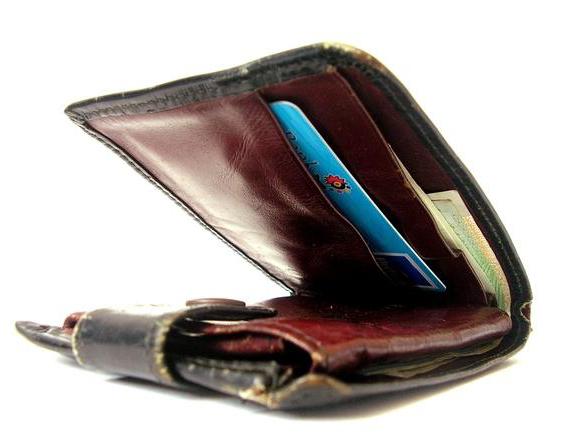A bill of exchange is a debt document of a statutory form that gives the indisputable right to demand payment of the amount after a certain period. Most often it is used by enterprises, providing each other with a commercial loan. Read more about what constitutes a simple and transferable bill, read on.
Features
Using bills as commercial loan It has a number of advantages over a standard loan agreement. A bill of exchange is a security that can be sold, mortgaged to a bank, or used for mutual settlements. His conversion is controlled by the rule of law. Unlike other debt obligations:
- a bill of exchange may be transferred without endorsement;
- all participants carry joint liability;
- it is not secured by collateral.
Types of bills
For clarity, we presented the varieties of this loan document in the form of a table.
| The form | Using |
| Commercial | Commodity loan |
| Financial | Cash loan |
| Bank | Certificate of deposit |
| Blank | The buyer signs a blank form and hands it to the seller to fill out |
| Collateral | It is written out as security for a loan from an unreliable borrower. |
For calculations, a simple and transferable bill of exchange is most often used. The first (solo) is issued by the debtor to the creditor. It contains an obligation to pay the amount on time. A transferable bill is issued by the borrower. It contains an order to the debtor to pay the specified amount (on time) to a third party. Such a document is called a draft. Since it does not have the power of a means of payment, in practice it is required that the debtor give his consent to the payment. Acceptance is carried out in the form of an inscription on the front side. The debtor can confirm payment of only part of the debt.
Commodity bills are used for settlements in the supply of products or services. Financial loans are issued to the company. They also draw up overdue payables. Bank bills certify the deposit of a certain amount. After its expiration, the investor will receive income. As a guarantee of payment for future deliveries of goods whose value has not yet been determined, the buyer can accept an empty form and transfer it to the seller to fill out. A bill of exchange may also be issued as security for a loan from an unreliable borrower. It will be kept in the deposited account. After payment, the bill is paid off. In case of violation of the terms, the debtor is presented with a claim.
The nuances of the law
The issue and circulation of such securities is regulated by No. 48-FZ “On the bill of exchange and promissory note” and Resolution No. 33/14. The nuances of taxation are covered in the Tax Code of the Russian Federation. In these legal acts, in particular, it is indicated that the bill is not subject to mandatory registration in the register. It can be written even on a white sheet of paper. The beneficiary may use all rights arising from the security himself or transfer them to a third party.
Legislation provides for the division of bills of exchange into commodity and financial. From an economic point of view, securities are also classified into discount and interest. In the second case, the commission for the use of funds is charged on the nominal amount from the next day after the paperwork. The Regulation “On a Promissory Note and a Promissory Note” provides that this period is valid only if a different date is not indicated in the details.Most often, organizations begin to accrue interest from the day the document is prepared. To avoid tax risks, it is better to skip the first day.
Registration
The Federal Law “On Transferable and Promissory Note” contains a list of the required details of the document:
- name;
- simple offer to pay a loan;
- debtor's address;
- payment term;
- place of settlement;
- name of the recipient;
- date and place of compilation of the document;
- signature of the drawer.
If at least one of the details is missing in the document, it shall be considered invalid.
Bill amount
It is clearly stated in the document in numbers and words. Any references to other debt instruments are prohibited. If they are present, then the bill of exchange loses force. If there are differences, the amount indicated in words is considered true. If several numbers are indicated, then the smallest is taken into account. Interest on the denomination of the draft is additionally charged at the rate indicated in the document. When transferring a document between several persons, splitting of the amount of debt is not allowed. The address of the payer (legal or natural person) is indicated at the bottom left.

Terms of payment
The Regulation “On a Promissory Note and a Bill of Exchange” provides for several calculation options:
- “Pay upon presentation.” The document may contain maximum and minimum terms, for example: “no later than July 25, 2015.” If there is no such inscription, then the debt can be recovered within a year from the moment the paper was drawn up. If the document is expired, the holder of the bill does not have the right to present claims.
- “Pay in (number of days) after presentation.” The countdown starts from the moment of acceptance. Unless otherwise indicated, payment must be made within a year.
- At some time after compilation. The countdown starts the day after the signing of the paper. The payment deadline is the date indicated in the document. If it is assigned to the beginning, middle or end of the month, it means 1, 15 and the last day.
- On a certain day: “I undertake to pay on September 10, 2015.” If the payment term falls on a weekend or holiday, then the money must be transferred on the next business day.
The Law on a Bill of Exchange imposes some restrictions. First, specifying consecutive payment deadlines is prohibited. The entire amount must be repaid at a time. Secondly, the term cannot be determined by the conditions for fulfilling other obligations.
Name and address of payment
This is an important attribute in the draft. Usually the address matches the location of the payer. The address of the bank in which the payment will be made can also be written. Specifying multiple places invalidates the document. In the column “Name” it is usually written: “Pay your name, LLC ...“. If the beneficiary is a bill holder, then it is indicated: “Pay by our order”.

A bill of exchange is considered invalid if it does not indicate the place of compilation. The address must be spelled out in full. Indication of time is necessary to resolve disputes. These details determine the maturity of the debt in documents with such payment periods: “after ... months from the preparation”, “upon presentation”, “after ... days from presentation“.
Signature of the drawer
The Federal Law "On a bill of exchange" provides for the indication of the full name before signing the drawer. This data is entered using a stamp. Without a signature, the document is considered invalid. If a security is issued by an enterprise, then it is signed by two persons who are responsible for financial settlements. The student may relinquish responsibility for acceptance marked “No obligation”. The appointment of a third party as a payer is not allowed. The bank repays the debt if there is a sufficient amount on the client’s account.
Implementation scheme
In transactions with drafts, a drawer (creditor), drawee (debtor) and receiver (remitter) are involved.Most often, the document is used for settlements, when the company and the first supplier take a loan for their production activities and repay the debt by payments from buyers. The drawee of the drawee is paid by the drawer, and the debtor by the surety. So the bank can control the targeted use of funds. After acceptance, the debtor has an obligation to the remitter. The lender agrees to pay the debt if the borrower has not confirmed or paid the bill. These rules apply only if the bill is presented on time for payment.
Promissory note
This security is issued by the debtor, undertaking to return a certain amount to the creditor on time. It must contain the same details as in the draft. The bill does not need to be further accepted. The same rules apply to the document regarding the order and terms of payments, mediation, lawsuits, copies, as well as to the draft.

Endorsement
The Federal Law "On a Promissory Note and a Bill of Exchange" provides for the transfer of the right to receive funds to another person. An organization that refuses to receive payment is called an endorser, the new beneficiary is called an endorser, and the operation itself is endorsed. A transaction can be made in favor of any person, even the drawer. Transfer of part of the rights is not allowed. An endorsement must be signed by a new lender.
Types of endorsements:
- Blank. The endorsement does not contain a clear name of the person in whose favor the payment should be made. A bill of exchange is considered to be bearer.
- Nominal (full). The endorsement shall indicate the name of the recipient of funds.
- Instructive. The inscription in the document “For collection”, “Currency to receive”, “I trust to receive” means that the holder transferred to the bank the right to collect funds from the borrower.
- Regulation “On a bill of exchange” provides that a security may be pledged. Then in the text the phrase is indicated: “Currency in collateral“. The holder of such a document has rights that arise from the draft.
Endorsement VS cession
A transfer bill may also be present on a promissory note. It is called cession. With its help, banks transfer deposit and savings certificates. These two details are different from each other.
- Unless otherwise specified in the document, the endorser is liable to all subsequent billholders. In the case of a cession, a person assigning his rights confirms their validity, but not their exercise.
- An endorsement, unlike a cession, provides for the complete transfer of rights.
- The Law “On a Promissory Note and a Bill of Exchange” allows for blank endorsement. Cession can be exclusively nominal.
- An endorsement is drawn up on an additional sheet, and the assignment is a separate agreement.
Draft acceptance
The debtor is obliged to confirm payment of the bill. The acceptance is executed on the left side of the document with the words: “Accepted,” “Pay”. Next should be the signature of the payer. You can present a bill for acceptance at any time during the period and after its validity. The debtor cannot keep the document for consideration. He is notified of the upcoming acceptance by registered letter, which details the details of the issue of the bill. But a drawee may limit the time limit for presenting a document.

The Law on a Promissory Note and a Bill of Exchange provides for partial acceptance. The debtor may also refuse to confirm the draft. But in this case, the buyer will not receive documents for the goods from the bank until he accepts the document. A credit institution may also issue an operation. Bank acceptance is used for early accounting. It is mandatory only if settlements are made by letter of credit.
Aval
A guarantee of payment for documents is their confirmation by banks. Aval - it is a guarantee making a payment by a financial institution, provided that the debtor has sufficient funds in the account.The essence of the operation is that the bill holder sells the security to the bank by endorsement before the due date. For this, he receives the bill amount minus the commission of the credit institution. The operation is taxed by the Central Bank at a rate of 0.3% of the amount.
Aval is given for any person responsible for the payment. The document must indicate for whom the guarantee is given. If these data are not available, it is considered that the aval is made by the creditor. Although in fact the payer of a bill of exchange is a borrower. Having repaid a security, the bank may submit a regression claim to the debtor.
Copies
In practice, not only the original document, but also several identical copies of it are often found in circulation. All of them must be numbered and indicated in the text of the bill. The first copy is designated as prima, the second - second, etc. Original signatures should be only in the original. All copies constitute one bill. Each copy may be in circulation.
One copy is sent for acceptance, the second is put into circulation. The payer confirms only the original. Then he passes it to the holder of the second copy. At endorsement, copies indicate the location of the other forms. The original is presented for payment, the remaining copies are repaid to them. Sometimes the terms of a security imply confirmation of all securities. Then the clause is used: “Pay against the second copy“. A copy of the document should reproduce the original with all marks. Such an instance may be avalanced; it must necessarily indicate the location of the first instance.

Payment procedure
The Convention “On a Promissory Note and a Promissory Note” provides that the countdown of a document’s maturity date starts on the day after its preparation. The security is presented for payment at the location of the borrower. Funds must be paid immediately in cash or non-cash. The payer must be returned with a receipt confirming receipt of payment. If the debtor has paid only part of the obligations, then a note is made in the document and a protest is filed.
Presentation of a bill before the deadline does not oblige the debtor to repay it. In turn, the document holder has the right to refuse to accept an advance payment. Extension of the bill is not allowed. If the parties have not found a different way, then it is necessary to draw up a new document on the same terms, but with the agreed dates.
Foreign trade bill of exchange is issued in one currency. If the terms of the contract provide for settlements in different monetary units, then separate documents must be prepared for each of them. Usually a security is issued in the currency of the country of the borrower. If the payment is made in a different currency, then the conversion rate is indicated in the document. If this data is not available, then the official data of the Central Bank of the country of the borrower will be considered correct.
Refusal of payment
A bill of exchange may not be accepted for acceptance if:
- Invalid payer address
- the debtor has died (individual) or is declared bankrupt;
- the document contains the phrase “not accepted”;
- the acceptance record is crossed out.
Challenging
Claims on issues of payment of bills are considered by the court only after a correctly drawn up protest. That is, after a request was made to pay off the accepted debt, but the funds were not received to the account of the creditor. To protest, the billholder must submit the document to the notary's office. Timing is clearly regulated. In case of refusal of payment, the bill holder will have 12 hours of the next business day. If the document is not confirmed, then the bill of exchange can be protested during the period of presentation of the acceptance. The notary office makes an entry in the registry and on the document itself. A state duty of 5% of the unpaid amount is charged for filing a protest.
If the payer is declared bankrupt, then you can immediately go to court. The drawer must notify the borrower of the filing of a protest within 4 days after its commission. Each endorser is required to notify his predecessor and the avalist in the next two days.
A claim can be filed even before the due date for payment, if there was a refusal of acceptance, the payer was declared insolvent, previous attempts to collect debt from the property were unsuccessful.
If the protest is filed in a timely manner, then:
- court authorities may accept cases for consideration;
- the right to pay the bill in regressive order comes, that is, the requirements are presented to the first avalists, endorsers;
- the holder of the bill may increase the amount payable by 6% per annum, which is accrued from the moment of maturity to repayment of debt, penalties, costs associated with the protest.
If the deadlines for protesting the draft are violated, the document holder loses all rights arising from it. This provision does not apply to a promissory note, as it is responsible for it, as well as an acceptor of its obligations.
If the text of the document contains the phrase: “Turnover without costs,” the bill holder may immediately go to court without protesting the bill. But this reservation does not exempt him from the timely presentation of the document, sending a notification. In case of a premature claim, the discount percentage is deducted from the bill amount.
Third parties
Between the holder of the bill of exchange and the borrower there may be intermediaries who confirm payment of the security for another debtor. Such a situation arises in case of partial or complete refusal of acceptance by the debtor, insolvency of the payer. But then the lawsuit must first be brought to the intermediary, and then to the main borrower. In the same sequence, payment must be made. Claims to the intermediary can be made only after the refusal to pay by the main borrower. Debt must be repaid in full. After that, the payer puts on the document the appropriate mark, the date of the transaction and takes the bill. After that, the intermediary has a regression requirement for the main debtor. The deadline for payment of the document is one day before the protest.








